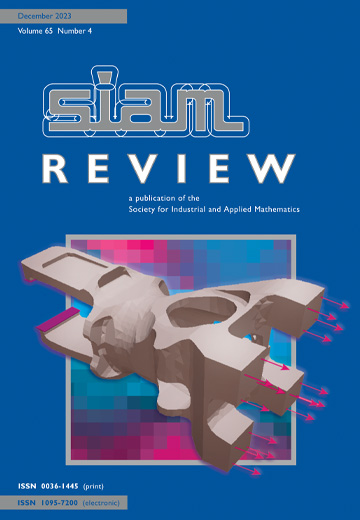Oscillatory Networks: Insights from Piecewise-Linear Modeling
IF 6.1
1区 数学
Q1 MATHEMATICS, APPLIED
引用次数: 0
Abstract
SIAM Review, Volume 66, Issue 4, Page 619-679, November 2024.There is enormous interest---both mathematically and in diverse applications---in understanding the dynamics of coupled-oscillator networks. The real-world motivation of such networks arises from studies of the brain, the heart, ecology, and more. It is common to describe the rich emergent behavior in these systems in terms of complex patterns of network activity that reflect both the connectivity and the nonlinear dynamics of the network components. Such behavior is often organized around phase-locked periodic states and their instabilities. However, the explicit calculation of periodic orbits in nonlinear systems (even in low dimensions) is notoriously hard, so network-level insights often require the numerical construction of some underlying periodic component. In this paper, we review powerful techniques for studying coupled-oscillator networks. We discuss phase reductions, phase--amplitude reductions, and the master stability function for smooth dynamical systems. We then focus, in particular, on the augmentation of these methods to analyze piecewise-linear systems, for which one can readily construct periodic orbits. This yields useful insights into network behavior, but the cost is that one needs to study nonsmooth dynamical systems. The study of nonsmooth systems is well developed when focusing on the interacting units (i.e., at the node level) of a system, and we give a detailed presentation of how to use saltation operators, which can treat the propagation of perturbations through switching manifolds, to understand dynamics and bifurcations at the network level. We illustrate this merger of tools and techniques from network science and nonsmooth dynamical systems with applications to neural systems, cardiac systems, networks of electromechanical oscillators, and cooperation in cattle herds.
振荡网络:片线性建模的启示
SIAM 评论》,第 66 卷第 4 期,第 619-679 页,2024 年 11 月。 人们对了解耦合振荡器网络的动力学有着极大的兴趣--无论是在数学上还是在各种应用中。这种网络在现实世界中的应用源于对大脑、心脏、生态等方面的研究。人们通常用复杂的网络活动模式来描述这些系统中丰富的突发行为,这些模式同时反映了网络组件的连通性和非线性动态。这种行为通常围绕锁相周期状态及其不稳定性展开。然而,非线性系统(即使是低维度)中周期轨道的显式计算是出了名的困难,因此网络层面的洞察力往往需要对一些底层周期成分进行数值构建。在本文中,我们回顾了研究耦合振荡器网络的强大技术。我们讨论了平滑动力系统的相位还原、相振幅还原和主稳定函数。然后,我们特别关注这些方法在分析片线性系统时的增强作用,因为我们可以很容易地为这些系统构建周期轨道。这将对网络行为产生有益的启示,但代价是我们需要研究非光滑动力系统。我们详细介绍了如何使用盐化算子来理解网络层面的动力学和分岔,盐化算子可以处理扰动在切换流形中的传播。我们通过神经系统、心脏系统、机电振荡器网络和牛群合作的应用,说明了网络科学和非平滑动力学系统的工具和技术的融合。
本文章由计算机程序翻译,如有差异,请以英文原文为准。
求助全文
约1分钟内获得全文
求助全文
来源期刊

SIAM Review
数学-应用数学
CiteScore
16.90
自引率
0.00%
发文量
50
期刊介绍:
Survey and Review feature papers that provide an integrative and current viewpoint on important topics in applied or computational mathematics and scientific computing. These papers aim to offer a comprehensive perspective on the subject matter.
Research Spotlights publish concise research papers in applied and computational mathematics that are of interest to a wide range of readers in SIAM Review. The papers in this section present innovative ideas that are clearly explained and motivated. They stand out from regular publications in specific SIAM journals due to their accessibility and potential for widespread and long-lasting influence.
 求助内容:
求助内容: 应助结果提醒方式:
应助结果提醒方式:


